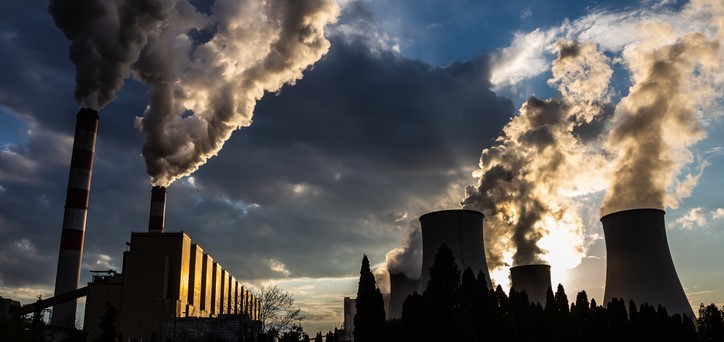February 15, 2024
Bad Neighbors: How Big Polluters and the Supreme Court Threaten Our Air
Sierra Club Senior Attorney

In an era where the phrase "unprecedented times" has become all too common, another remarkable chapter is set to unfold in our highest court. On February 21, the Supreme Court is poised to bypass traditional procedure, hearing a case from the shadow docket before the D.C. Circuit reaches the merits—a move that sidesteps the D.C. Circuit and ventures away from standard court review—at the request of polluters who don’t want to reduce their smog-causing pollution that blows across state lines.
The result could leave millions unprotected from harmful smog pollution while threatening the balance of power within our judicial system.
Air Pollution Makes for a Bad Neighbor
To understand the significance of this case, we must begin with wind. Pollution from sources including fossil fuel power plants and factories doesn’t stop at state lines, but instead can travel hundreds of miles, and create serious air quality problems far from the original offender. Because of prevailing wind patterns in North America, pollution from uncontrolled and undercontrolled sources in places like Texas and the Ohio River Valley can cause air quality problems far away in the Upper Midwest, the Mid-Atlantic, and the Northeast, even if those downwind areas have taken steps to strictly control their own polluters.
This is not a trivial matter: the air pollution from upwind states is so severe, it can make it nearly impossible for downwind states to attain and maintain “EPA’s health-based air quality standard for ground-level ozone (or “smog”), known as the 2015 Ozone National Ambient Air Quality Standards (NAAQS),” presenting a thorny problem of interstate equity.
Fortunately, the Clean Air Act has a solution to this: every state is not only required to develop and submit plans to EPA detailing how they will attain and maintain air quality standards such as the Ozone NAAQS within their borders, but is also required to develop plans to prevent their pollution from hindering other states from attaining and maintaining air quality standards. However, the unfortunate reality is that states often fall down on that second obligation; in fact, 23 states either submitted “do-nothing” plans to address their cross-state ozone pollution or didn’t bother submitting plans at all.
Downwind states faced deadlines in 2023 and 2026 for attaining the Ozone NAAQS, and so EPA stepped in with the Good Neighbor Plan, designed to ensure states are being good neighbors by reducing the pollution from coal plants and other industry that contributes significantly towards downwind smog problems in other states. The rule, finalized in March 2023, updates a system that has been in place in the eastern U.S. for over a decade that has successfully and cost-effectively cleaned up some of our worst sources of air pollution.
The 2023 Good Neighbor Plan
In many ways, the Good Neighbor Plan is just the latest in a long line of ozone transport rules starting with the 1998 NOx SIP Call, the 2011 Cross State Air Pollution Rule, the 2016 Cross State Air Pollution Update, and the 2020 Revised Cross State Air Pollution Update. These rules have been court-validated, including by the DC Circuit in 2023, and the Supreme Court in 2014.
Like those rules, the Good Neighbor Plan functions by determining first which areas across the country are failing or having trouble maintaining national ozone standards and what states are contributing pollution to those areas, and then setting two types of emission reductions for those states that are “linked” to the downwind ozone problem spots. In the Good Neighbor Plan, those reductions take the form of (1) a set of allowances for ozone precursor pollution from power plants, and/or (2) a set of emission limits for other large industrial sources of ozone precursor pollution, like incinerators, pulp mills, pipelines, and glass factories. These requirements phase in over several years, with the Good Neighbor Plan becoming fully implemented in 2026.
The health benefits are monumental. EPA projects that when fully implemented in the 23 states it covers, the rule will:
- prevent approximately 1,300 premature deaths,
- save over 2,300 visits to hospitals and emergency rooms,
- cut asthma symptoms by 1.3 million cases,
- avoid 430,000 school absence days, and
- prevent 25,000 lost work days.
The rule is also projected to bring $13 billion in annual net benefits for decades to come. But despite these clear advantages and the Clean Air Act’s mandate that states address air pollution they send downwind, several states and polluter industry groups have stymied implementation of the rule by filing challenges to EPA’s authority to address ozone transport in multiple regional Circuit courts. These cases have delayed critical health and environmental protections, but don’t reach the merits of the Good Neighbor Plan itself. As those cases reach the merits, some states could be restored to the Good Neighbor Plan, if EPA’s authority to address ozone transport where the states have failed to is vindicated.
Nonetheless, today the Good Neighbor Plan is being implemented in Illinois, Indiana, Maryland, Michigan, New Jersey, New York, Ohio, Pennsylvania, Virginia, and Wisconsin, and California is subject to requirements that are scheduled to take effect in the 2026 ozone season. In January, EPA also proposed adding five new states to the rule, expanding it to include Arizona, Iowa, Kansas, New Mexico and Tennessee.
Even with the rule only partially implemented, the public is benefiting. Harmful ozone-season NOx pollution (a key smog precursor pollutant) has dropped 18 percent in the 10 states that implemented the program in 2023. And under the entire collection of cross-state ozone transport programs, ozone season NOx emissions have dropped over 50 percent since 2015.
But many communities are still waiting to experience the full public health and economic benefits of the rule. Pursuant to temporary court orders, EPA is currently not implementing the rule in 12 states: Alabama, Arkansas, Kentucky, Louisiana, Minnesota, Mississippi, Missouri, Nevada, Oklahoma, Texas, Utah, and West Virginia. What’s more, the states who are experiencing the benefits of the Good Neighbor Plan could soon see these improvements slip away.
Understanding Legal Challenges to the Good Neighbor Plan
Polluter states and industry groups are challenging the Good Neighbor Plan before the D.C. Circuit Court of Appeals. As unfortunate as those challenges may be, procedurally, that’s normal. And also normal is the fact that the D.C. Circuit rejected those challengers’ requests that the Good Neighbor Plan be stayed (as noted above, ozone transport rules like the Good Neighbor Plan have been repeatedly validated by the courts) and directed the parties to move forward with briefing on the merits.
But what’s not normal is that last fall those same challengers–including the National Mining Association, American Forest & Paper Association, Midwest Ozone Group, Enbridge, Interstate Natural Gas Association of America, and American Petroleum Institute and the attorneys general of Indiana, Ohio, and West Virginia–filed applications on the Supreme Court’s shadow docket, seeking to go around the D.C. Circuit’s order rejecting a stay. Less normal still is that the Supreme Court requested briefing and argument from the parties. As a result, the Supreme Court could be deciding the future of the Good Neighbor Plan despite the D.C. Circuit never having a chance to review merits briefs, hear oral argument, or issue a decision. Effectively, polluter states and industry have tried to jump the queue right to the Supreme Court, sidelining the D.C. Circuit in the process, and the Supreme Court appears to be going along with it.
That’s not how court review is supposed to work.
Congress directed that national Clean Air Act rules like the Good Neighbor Plan be reviewed first of all in the D.C. Circuit, enabling any controversy to be fully developed with briefs, argument, and a written opinion, before a case might arrive on the Supreme Court’s docket. By upending this normal procedure, the D.C. Circuit is stuck in limbo, the Supreme Court is deprived of a full record and fully developed arguments, and the public is left wondering whether critical air quality protections will be stripped away. Given that the Supreme Court in 2014 upheld a prior ozone transport rule, the 2024 Supreme Court’s willingness to short-circuit the process here with the Good Neighbor Plan is troubling.
While legal and environmental experts await the Supreme Court’s decision, it is children, families, and vulnerable communities that have the most to lose. For people in states subject to harmful smog from upwind polluters, this rule is their primary defense and their greatest hope of addressing cross-state air pollution.
_____________________
 Zachary Fabish is a senior attorney with the Sierra Club's Environmental Law Program, where he focuses on power sector litigation and EPA rulemakings.
Zachary Fabish is a senior attorney with the Sierra Club's Environmental Law Program, where he focuses on power sector litigation and EPA rulemakings.
The American Constitution Society is a 501(c)(3) non-profit, non-partisan legal organization. The views expressed on the Expert Forum are those of the authors and do not represent the American Constitution Society or its chapters.
Environmental Protection, Environmental Regulation, Regulation and the Administrative State




